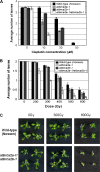Inefficient double-strand DNA break repair is associated with increased fasciation in Arabidopsis BRCA2 mutants
- PMID: 19457980
- PMCID: PMC2692019
- DOI: 10.1093/jxb/erp135
Inefficient double-strand DNA break repair is associated with increased fasciation in Arabidopsis BRCA2 mutants
Abstract
BRCA2 is a breast tumour susceptibility factor with functions in maintaining genome stability through ensuring efficient double-strand DNA break (DSB) repair via homologous recombination. Although best known in vertebrates, fungi, and higher plants also possess BRCA2-like genes. To investigate the role of Arabidopsis BRCA2 genes in DNA repair in somatic cells, transposon insertion mutants of the AtBRCA2a and AtBRCA2b genes were identified and characterized. atbrca2a-1 and atbrca2b-1 mutant plants showed hypersensitivity to genotoxic stresses compared to wild-type plants. An atbrca2a-1/atbrca2b-1 double mutant showed an additive increase in sensitivity to genotoxic stresses compared to each single mutant. In addition, it was found that atbrca2 mutant plants displayed fasciation and abnormal phyllotaxy phenotypes with low incidence, and that the ratio of plants exhibiting these phenotypes is increased by gamma-irradiation. Interestingly, these phenotypes were also induced by gamma-irradiation in wild-type plants. Moreover, it was found that shoot apical meristems of the atbrca2a-1/atbrca2b-1 double mutant show altered cell cycle progression. These data suggest that inefficient DSB repair in the atbrca2a-1/atbrca2b-1 mutant leads to disorganization of the programmed cell cycle of apical meristems.
Figures





References
-
- Alexander MP. Differential staining of aborted and nonaborted pollen. Stain Technology. 1969;44:117–122. - PubMed
-
- Aono N, Sutani T, Tomonaga T, Mochida S, Yanagida M. Cnd2 has dual roles in mitotic condensation and interphase. Nature. 2002;417:197–202. - PubMed
-
- Bleuyard JY, Gallego ME, White CI. Recent advances in understanding of the DNA double-strand break repair machinery of plants. DNA Repair. 2006;5:1–12. - PubMed
Publication types
MeSH terms
Substances
LinkOut - more resources
Full Text Sources
Miscellaneous

